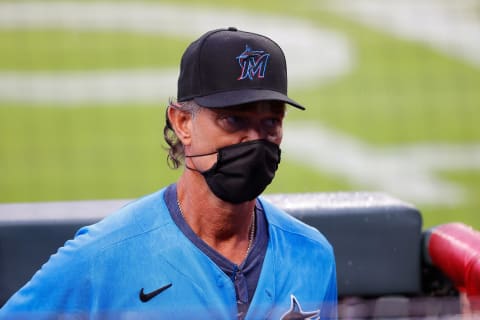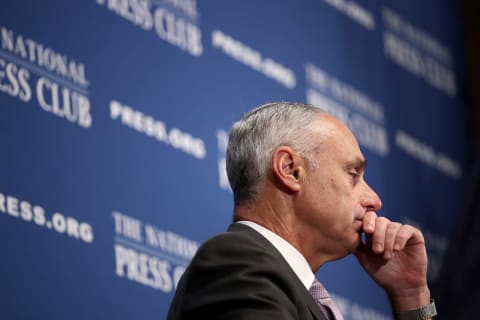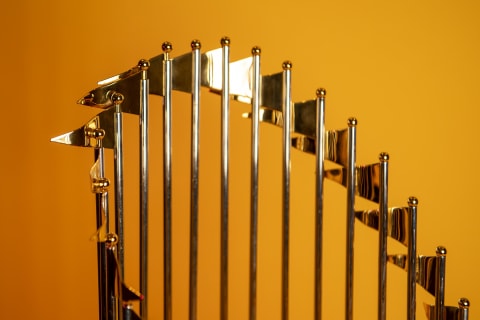2020 MLB Season: Baseball in a COVID-19 world, a blueprint


Given the most recent developments, the 2020 MLB season hinges on baseball updating the current system. Here’s a blueprint for how to do that.
Alright, baseball, you won’t do the work to keep your players, coaches, and staff members safe. So, since you’re all about dollars and cents, I’ll give you a blueprint for how to pull off the 2020 MLB season during a worldwide pandemic completely FREE of charge.
ONE – First and foremost, it’s too late to institute a bubble, which I’ll give Rob Manfred credit for because it is the first idea proposed by his camp and rejected by players. It’s not too late to implement a league-wide rapid testing system.
More from Call to the Pen
- Philadelphia Phillies, ready for a stretch run, bomb St. Louis Cardinals
- Philadelphia Phillies: The 4 players on the franchise’s Mount Rushmore
- Boston Red Sox fans should be upset over Mookie Betts’ comment
- Analyzing the Boston Red Sox trade for Dave Henderson and Spike Owen
- 2023 MLB postseason likely to have a strange look without Yankees, Red Sox, Cardinals
10 teams have already opted-in to use a rapid COVID-19 antigen testing system designed by two Dallas-based companies Viviature and Diamond Physicians, according to The Dallas Morning News. There’s no excuse for such a system not to be used by all 30-MLB teams.
The current system MLB currently utilizes requires tests to be conducted every 48-hours, and we’ve already seen instances in which results aren’t produced before the next test is to be administered, rendering them useless.
Already, during the 2020 MLB season, we’ve seen two examples in which this system has failed. The first occurred hours before the first pitch of the season was delivered last Thursday, when it was reported that Juan Soto of the Washington Nationals had tested positive for COVID-19.
That test was administered on Tuesday, 48-hours before, and in the time in between, Soto participated in practice and workouts, potentially exposing other Nats players to the virus. The opening series between the Nats and the New York Yankees proceeded despite this fact.
Thankfully, no one else has tested positive on either team… yet.
Related Story. MLB COVID oubreak: It's Time to Reconsider the Bubble. light
The second occurrence happened this weekend in a series between the Marlins and the Philadelphia Phillies. Four Marlins players had already tested positive for COVID-19 but the results of the most recent test hadn’t been delivered before game-time on Sunday, thus the players decided to play.
Come Monday, 14 members of the Marlins, it turns out, also tested positive for the virus, potentially exposing members of the Phillies who were set to kick off a 2-game series against the Yankees on Monday. Thankfully, that game was canceled until the results of a more recent test are delivered and all teams can be assured that there are no COVID-positive players on the field.
All of this can be avoided with a rapid test, which brings me to…

For the 2020 MLB season to continue, protocols simply need to be enforced.
TWO – Once baseball implements a league-wide rapid testing system for the 2020 MLB season, it must also enforce a rule which states that any team that does not produce up-to-date test results prior to a game, must forfeit the game.
This will provide teams with the incentive to opt-in to the Viviature and Diamond Physicians or any rapid testing system. It also will provide league-wide peace of mind when it comes to playing under these current conditions.
In case you’re wondering, yes! If this type of rule is to be enforced, the Miami Marlins would have to forfeit all of these games being postponed against the Baltimore Orioles.
Marlins outbreak highlights why Manfred, Clark should resign. light. Related Story
Unfortunately, given the current conditions, a zero-tolerance policy will have to be enforced, even if it costs teams a game. Perhaps then players, coaches, or any staff members will take the protocols seriously and such outbreaks will be avoided.
No player, coach, umpire, or staff member should have any doubt about their current status regarding this virus, especially when they are free to live their lives outside of the ballfield in a country that has ZERO control of the virus.
THREE – Health and safety protocols regarding mask-wearing, celebrations, high-fiving, social distancing should be strictly enforced. Anyone who violates these rules and protocols should be suspended until two negative tests are produced.

Beyond the 2020 MLB season, MLB will need a comprehensive plan for the playoffs.
FOUR – Baseball should begin working on producing a California based postseason bubble for the 2020 MLB season. The playoffs are set to begin in October, giving the league more than two months to organize the specifics and pull it off without a hitch.
Here’s how it would look:
More from MLB News
- MLB Power Rankings: Atlanta Braves still on top with major shifting below them
- Caesars MLB Promo Code: Two Shots at Picking the World Series Winner!
- MLB Power Rankings: Atlanta Braves still on top amid a big shake-up in top 10
- DraftKings MLB Promo: Bet $5 on an Anytime Home Run, Win $150 Bonus GUARANTEED
- MLB Power Rankings: After MLB trade deadline, gap is closing on Atlanta Braves
Under MLB’s current expanded postseason system, eight teams can make the playoffs in each league. That’s 16 teams in total and four rounds of October baseball.
The American League’s postseason bubble would take place in Dodger Stadium and Angel Stadium, which are approximately a 35-minute drive apart.
The National League’s postseason bubble would take place in Oracle Park (home of the San Francisco Giants) and RingCentral Coliseum (home of the Oakland Athletics). These stadiums are approximately an 18-minute drive apart.
Based on matchups, teams will be given a dedicated stadium to play in. Round 1 in the AL could look like this, for example:
- Team 1 vs Team 8 – Round 1 games played in Dodger Stadium
- Team 2 vs Team 7 – Round 1 games played in Angel Stadium
- Team 3 vs Team 6 – Round 1 games played in Dodger Stadium
- Team 4 vs Team 5 – Round 1 games played in Angel Stadium
Round 2:
- Team 1 vs Team 4 – Round 2 games played in Dodger Stadium
- Team 2 vs Team 3 – Round 2 games played in Angel Stadium
Round 3:
- Team 1 vs Team 2 – Round 3 games played in Dodger Stadium
MLB Postseason retooled for 2020. light. Related Story
Between rounds, since teams will potentially have to move to another stadium to play their games, allow 48-hours for MLB to conduct a deep cleaning of each stadium and hotels. In this time, teams should continue testing their players.
The World Series could then be played in a separate neutral site, preferably a domed stadium. To avoid long travel, they can play the games in Chase Field (home of the Arizona Diamondbacks).
dark. Next. If Marlins Outbreak Doesn't Stop MLB, What Will?
There you have it. An extensive system that will work and all it took me was approximately 120-minutes to come up with it.